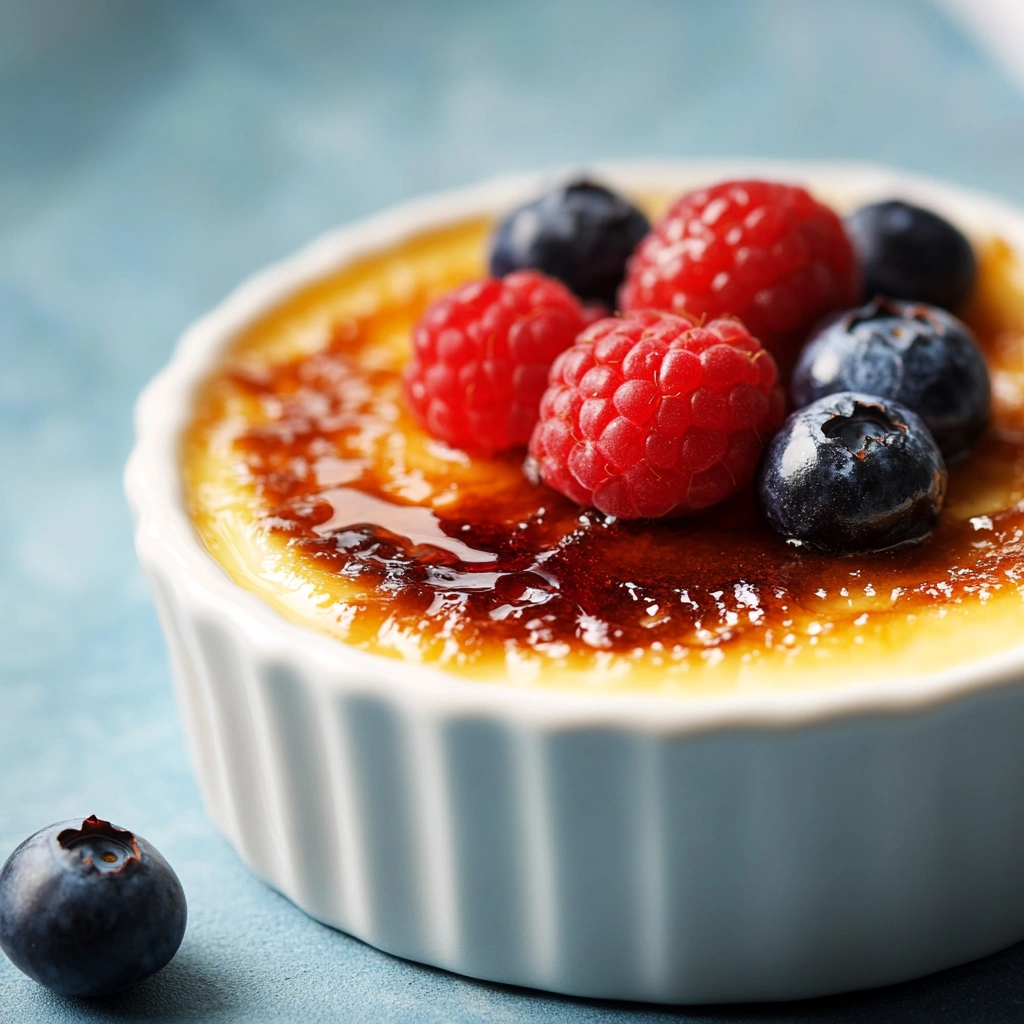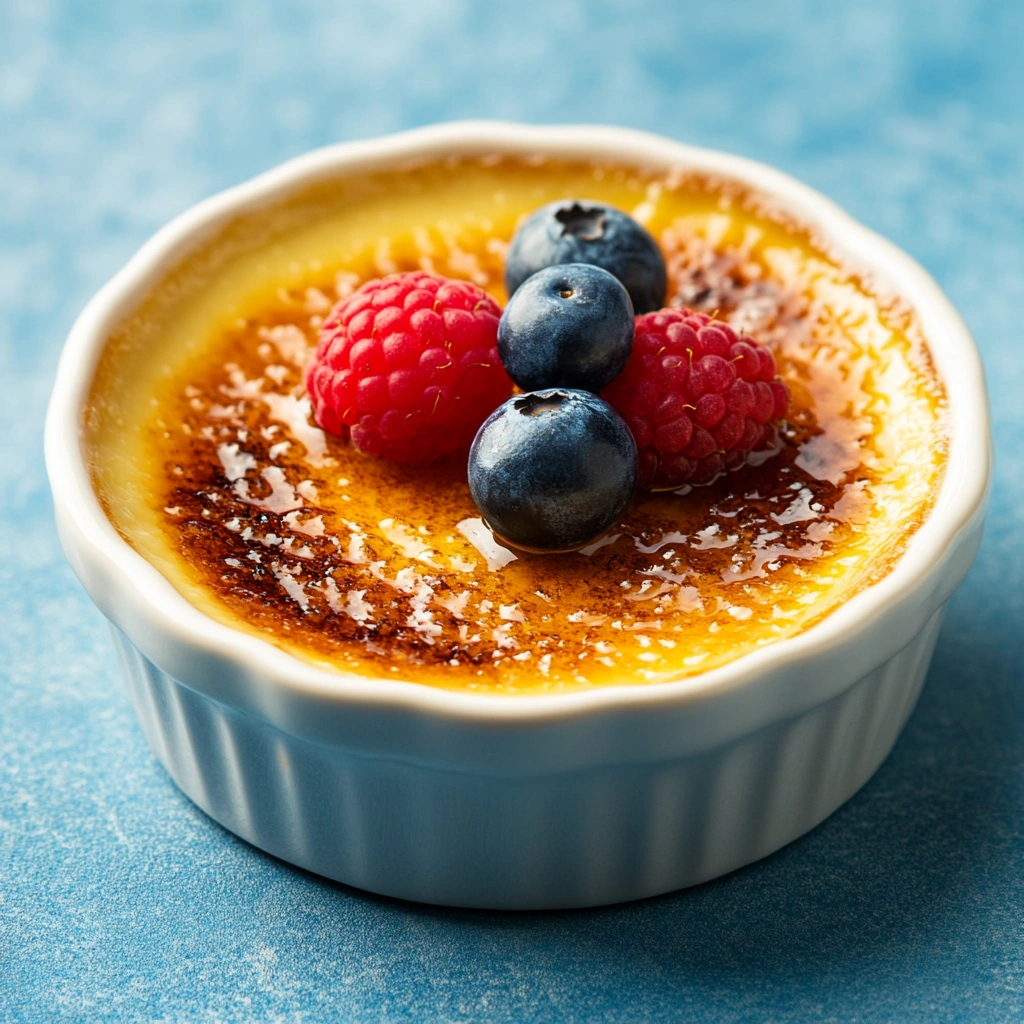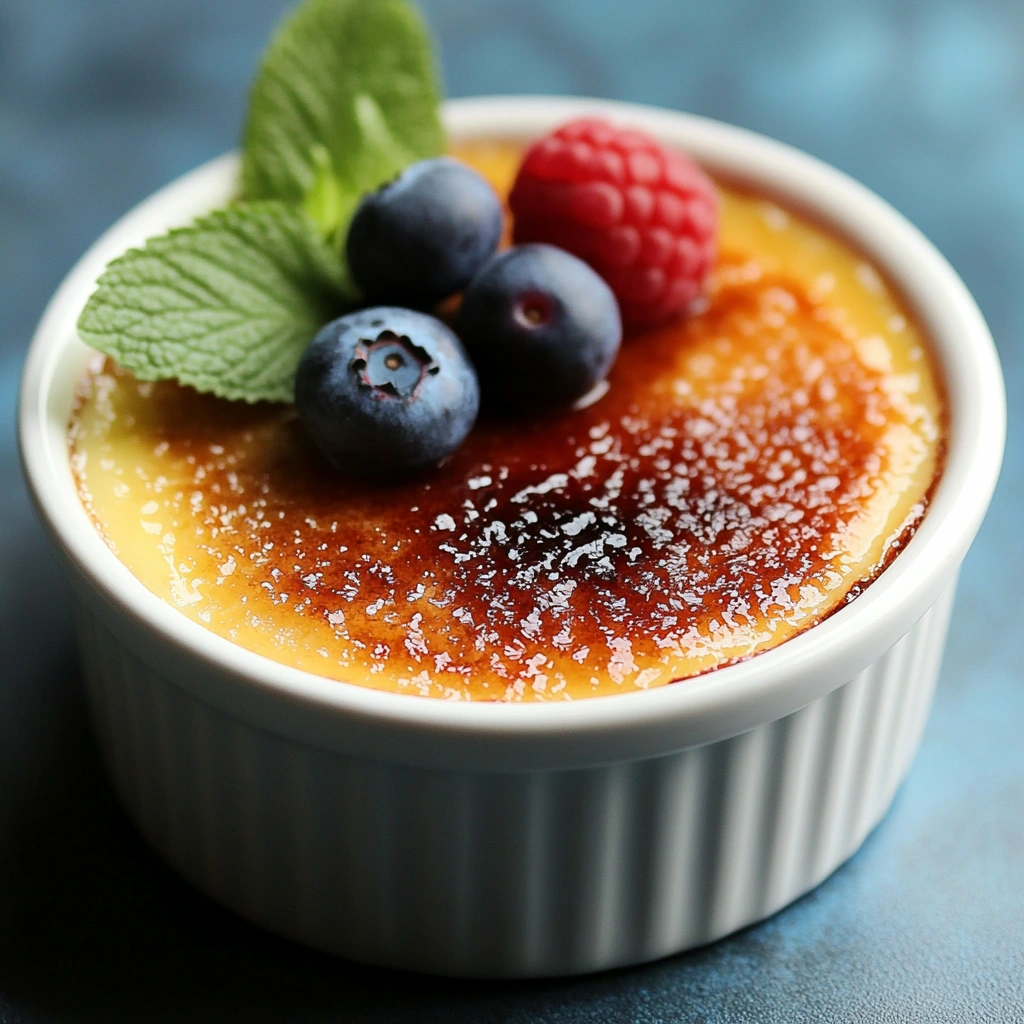Crème brûlée is the epitome of elegance in desserts. A simple combination of cream, egg yolks, sugar, and vanilla transforms into a luxurious, silky custard beneath a perfectly caramelized sugar crust. Yet, achieving perfection requires precision.
In this guide, we’ll uncover the secret to crème brûlée, covering essential custard techniques, ingredient selection, and baking methods. Whether you’re a home cook or a seasoned pastry chef, these expert insights will help you craft crème brûlée with confidence.
For those curious about how crème brûlée compares to other custards, check out this detailed guide on crème brûlée vs. custard.
Introduction: The Ultimate Secret to Crème Brûlée
Why Crème Brûlée is Both Simple and Complex
At its core, crème brûlée consists of just a few ingredients, yet perfecting it requires attention to detail. The balance between a creamy custard and a crisp, caramelized top is what makes this dessert a true art form.
The Key Elements: Custard, Caramelized Sugar, and Technique
- Custard: A rich blend of cream, egg yolks, and sugar.
- Caramelized Sugar: Achieved by torching a thin layer of sugar until golden and crisp.
- Technique: Proper mixing, baking, and finishing techniques are crucial.
If you enjoy learning about dessert techniques, explore the secret to good crumble to understand how texture plays a role in baking.
Common Misconceptions About Making the Perfect Dessert
Despite its reputation, crème brûlée is not difficult to master. Some common myths include:
Overheating the cream is necessary—In reality, gentle heating prevents curdling.
Skipping the water bath is fine—This leads to uneven cooking and grainy custard.
Using any sugar works for caramelization—Some types burn too quickly.
The Secret to Crème Brûlée’s Perfect Custard
The foundation of crème brûlée is its custard. Achieving a smooth, velvety texture requires proper ingredient ratios and careful preparation.
Balancing Egg Yolks, Cream, and Sugar for a Smooth Texture
The secret to crème brûlée’s creamy texture lies in the perfect ratio of ingredients:
- Heavy Cream: Provides richness and structure.
- Egg Yolks: Add smoothness and help set the custard.
- Sugar: Sweetens while stabilizing the mixture.
Tip: A reliable formula is 2 cups of cream, 5 egg yolks, and ½ cup of sugar for a balanced custard.
For a deeper dive into ingredient variations, check out creme brulee vs. custard to see how different dairy and egg ratios impact texture.
The Importance of Slow Heating to Avoid Curdling
Heating the cream too quickly can result in scrambled eggs rather than custard. The best method is below:
- Warm the cream gently over low heat.
- Slowly pour it into the whisked egg yolks while stirring—this is called tempering.
- Strain the mixture to remove air bubbles and ensure a smooth texture.
Mistake to Avoid: Whisking too aggressively, which creates unwanted foam and an uneven texture.
The Secret to Crème Brûlée Ingredients: Quality Matters
Why Vanilla Beans Elevate the Flavor
One of the secrets to crème brûlée’s deep, aromatic flavor is high-quality vanilla. Options include:
- Vanilla Beans: Deliver the richest taste with beautiful specks.
- Pure Vanilla Extract: A good alternative if beans aren’t available.
- Vanilla Bean Paste: Offers concentrated flavor without the hassle of scraping pods.
If you’re a fan of classic dessert flavors, you might also like this magnolia banana pudding recipe, another rich and creamy dessert.
Choosing the Right Cream-to-Milk Ratio for Richness
- 100% Heavy Cream: Ensures the creamiest custard.
- Half Heavy Cream, Half Whole Milk: Produces a slightly lighter texture.
Tip: Using all heavy cream is the secret to crème brûlée’s luxurious mouthfeel.
The Best Type of Sugar for a Flawless Brûlée Top
- Superfine Sugar: Melts evenly for a smooth crust.
- Granulated Sugar: Works well but may take longer to caramelize.
- Brown Sugar: Adds caramel depth but burns quickly.
For another recipe that relies on caramelization techniques, try this sweet potato brownies recipe.
The Secret to Crème Brûlée’s Ideal Baking Process
Even with the perfect custard, baking mistakes can ruin the final result. A water bath, proper oven temperature, and checking for doneness are key to success.
Why a Water Bath (Bain-Marie) is Essential
Crème brûlée requires gentle, even heat to prevent curdling. A water bath:
Prevents the custard from overheating.
Helps it cook evenly without cracking.
Keeps the texture silky and smooth.
How to Set Up a Water Bath
- Place ramekins in a deep baking dish.
- Pour hot water around them until it reaches halfway up the sides.
- Bake at 300°F (150°C) for 30-40 minutes.
The Right Oven Temperature and Timing for Perfect Texture
Too High (350°F+): The custard may curdle.
Too Low (Below 275°F): It won’t set properly.
Ideal (300°F-325°F): Ensures a creamy consistency.
For other precise temperature-sensitive recipes, check out this easy yellow rice recipe, which also benefits from controlled heat.
How to Check for the Perfect Custard Set (The Wobble Test)
- Gently shake the ramekin—the center should jiggle slightly but not be liquid.
- If it’s too loose, bake for another 5 minutes, then check again.
- Overbaking causes a grainy texture.

The Secret to Crème Brûlée’s Signature Caramelized Sugar
Choosing the Best Sugar for the Secret to Crème Brûlée’s Crisp Topping
The secret to crème brûlée lies in its balance between creamy custard and a crisp caramelized sugar crust. However, choosing the right sugar is crucial:
- Superfine Sugar: The best option for an even caramelization process.
- Granulated Sugar: Works well but takes longer to melt.
- Brown Sugar: Adds caramel depth but burns quickly.
Tip: A thin, even layer of sugar ensures the best results for the secret to crème brûlée’s signature crackly topping.
For another dessert where sugar choice affects texture, try Magnolia Banana Pudding.
Torch vs. Broiler: The Secret to Crème Brûlée’s Perfect Sugar Crust
There are two common methods for caramelizing the sugar:
Using a Kitchen Torch:
- Provides better control over caramelization, preventing burnt spots.
- Allows for an even golden crust without overheating the custard.
Using a Broiler:
- Works as a backup method but requires careful monitoring.
- Must be watched closely to avoid burning the sugar before it caramelizes evenly.
Avoiding Mistakes in the Secret to Crème Brûlée’s Caramelization
Too Much Sugar: Creates a thick crust that doesn’t crack properly.
Torch Held Too Close: Burns the sugar instead of caramelizing it.
Not Moving the Torch Evenly: Results in uneven browning.
For another dessert that involves careful sugar caramelization, check out Sweet Potato Brownies.
The Secret to Crème Brûlée Success: Avoiding Common Mistakes
Even experienced bakers can struggle with the secret to crème brûlée. Here’s how to avoid the most frequent mistakes:
The Secret to Crème Brûlée’s Silky Texture: Avoiding Grainy or Overcooked Custard
- Overheating the Custard Mixture: Causes eggs to scramble. Always heat the cream slowly and temper the yolks gradually.
- Baking at Too High a Temperature: Leads to a curdled texture. Stick to 300°F (150°C) with a water bath.
Fixing Watery or Runny Crème Brûlée
- Undercooked Custard: If the custard is too soft, bake for 5-10 extra minutes until it passes the wobble test.
- Not Enough Egg Yolks: The secret to crème brûlée’s firmness is using the right egg ratio. Adjust by adding one extra yolk if needed.
What to Do If the Sugar Doesn’t Caramelize Properly
If the sugar won’t caramelize, try the following:
Use dry, fine sugar—moisture prevents proper browning.
Apply an even sugar layer to allow uniform heating.
Move the torch continuously to prevent overheating in one spot.
For another dish that requires careful heat control, check out Easy Yellow Rice Recipe.
The Secret to Crème Brûlée Variations and Flavors
While classic vanilla is the most popular, the secret to crème brûlée is that it can be customized with unique flavors.
Classic Vanilla vs. Creative Infusions in the Secret to Crème Brûlée
- Traditional Vanilla Bean Crème Brûlée: The gold standard with deep, aromatic flavor.
- Citrus-Infused Crème Brûlée: Lemon, orange, or yuzu zest adds a refreshing contrast.
- Coffee Crème Brûlée: A dash of espresso powder enhances the richness.
Liqueurs and Exotic Flavors in the Secret to Crème Brûlée
- Baileys or Kahlúa: Adds a sophisticated twist.
- Matcha or Earl Grey Tea: Provides earthy and floral notes.
- Spiced Crème Brûlée: Cinnamon, nutmeg, or cardamom introduces warmth.
For another dessert that showcases bold flavors, try Strawberry Crunch Cheesecake.
Dairy-Free and Alternative Ingredient Options for the Secret to Crème Brûlée
If you need a lactose-free option, consider these substitutes to be on a safer side:
- Coconut Milk: Adds a tropical twist while maintaining creaminess.
- Almond or Cashew Cream: Works well for a nutty, rich flavor.
- Maple Syrup Instead of Sugar: Introduces a natural sweetness.
For more creative ingredient swaps, check out Homemade Rice Cakes.
The Secret to Crème Brûlée Presentation
Even the perfect crème brûlée can be improved with beautiful presentation.
Choosing the Right Ramekins for the Secret to Crème Brûlée’s Perfect Texture
Shallow Ramekins (4-5 inches wide): Ideal for a thin sugar crust and even custard layer.
Deep Ramekins (2-3 inches tall): Creates a thicker custard, but the sugar-to-custard ratio changes.
Tip: The secret to crème brûlée’s ideal texture is even heat distribution, which is easier to achieve in wider ramekins.
Garnishes That Complement the Secret to Crème Brûlée’s Flavor
Fresh Berries: Raspberries, strawberries, or blueberries for tart contrast.
Mint Leaves: Adds a fresh, elegant touch.
Edible Gold: A luxury addition for a gourmet presentation.
For another beautifully presented dessert, try Peach Crumble Recipe.
The Secret to Crème Brûlée’s Ideal Serving Temperature
- Chill for at Least 2 Hours: This sets the custard properly.
- Serve Slightly Cool, Not Ice-Cold: Let it sit at room temperature for 10-15 minutes before serving.
For a warm dessert alternative, check out Churro Cheesecake Recipe.

The Secret to Crème Brûlée Storage and Make-Ahead Tips
How Long You Can Store Crème Brûlée Before Serving
One of the advantages of crème brûlée is that it can be prepared in advance without compromising its texture. The custard can be refrigerated for up to three days before caramelizing the sugar topping. However, proper storage is necessary to maintain the secret to crème brûlée’s smooth consistency.
- Cover the ramekins with plastic wrap to prevent the custard from absorbing odors.
- Store the ramekins on a flat surface to ensure an even texture.
- Caramelize the sugar topping just before serving to maintain its signature crispness.
Can You Freeze Crème Brûlée? What Happens If You Do?
While crème brûlée can technically be frozen, the texture may suffer upon thawing. The freezing process can cause the custard to become grainy or watery. If freezing is necessary, follow these guidelines:
- Freeze only the custard base, not the caramelized sugar topping.
- Thaw in the refrigerator overnight rather than at room temperature.
- Avoid reheating directly, as high heat can alter the consistency.
Freezing after caramelization is not recommended, as the sugar crust will become soggy and lose its characteristic crunch.
For another make-ahead dessert, check out Magnolia Banana Pudding.
Reheating Without Ruining the Texture
Crème brûlée is best served chilled, but if it has been stored for several days, allowing it to reach the ideal temperature before serving is crucial.
- Let refrigerated custards sit at room temperature for 10 to 15 minutes before caramelizing the sugar.
- Avoid microwaving, as it can cause the eggs to curdle.
- If necessary, warm the ramekins in a hot water bath for a few minutes before serving.
For another dish where careful reheating matters, try Easy Yellow Rice Recipe.
The Secret to Crème Brûlée Drink Pairings
The right beverage pairing can enhance the secret to crème brûlée, balancing its sweetness and creaminess with complementary flavors.
The Best Wines and Liqueurs to Complement the Secret to Crème Brûlée
- Sauternes is a classic choice, offering honey and apricot notes that complement the vanilla custard.
- Moscato d’Asti provides a light, slightly sparkling option that refreshes the palate.
- Baileys or Amaretto adds a smooth, nutty contrast to the caramelized sugar.
For another rich, creamy dessert with ideal pairing options, check out Strawberry Crunch Cheesecake.
Coffee, Tea, and Non-Alcoholic Options for the Secret to Crème Brûlée
- Espresso balances the sweetness of crème brûlée with its deep, roasted flavor.
- Chai tea offers a warm, spiced profile that pairs well with the custard’s vanilla and caramel notes.
- Vanilla almond milk provides a non-dairy pairing that complements the custard’s richness.
Perfect Dessert Pairings for the Secret to Crème Brûlée
- Shortbread cookies add a subtle crunch to contrast with the creamy custard.
- Dark chocolate truffles enhance the caramelized sugar’s depth of flavor.
- Citrus sorbet provides a refreshing counterbalance to the dessert’s richness.
For another dessert with complementary flavors, try Peach Crumble Recipe.
The Secret to Crème Brûlée Mastery: Expert Tips & FAQs
Can Crème Brûlée Be Made Without a Torch?
Yes, crème brûlée can be caramelized using a broiler instead of a torch. However, the broiler method requires careful attention to prevent burning.
- Set the broiler to high and position the ramekins on the top oven rack.
- Watch closely, as the sugar can caramelize within one to three minutes.
- Rotate the ramekins for even browning.
For another dessert that requires careful caramelization, check out Sweet Potato Brownies.
How to Tell When Crème Brûlée is Baked Perfectly
The secret to crème brûlée’s ideal texture is mastering the wobble test.
- Gently shake the ramekin; the center should jiggle slightly, but the edges should be set.
- If the center is too liquid, bake for an additional five minutes before checking again.
- Overbaking will result in a curdled, grainy texture.
The Best Sugar for Caramelization
The type of sugar used affects the final texture of the caramelized topping.
- Superfine sugar is the best option for even caramelization.
- Granulated sugar works well but takes longer to melt.
- Brown sugar adds depth but can burn too easily.
For another recipe where sugar choice is key, try Churro Cheesecake Recipe.
Final Thoughts: The True Secret to Crème Brûlée Perfection
Why Patience and Precision Matter in the Secret to Crème Brûlée
The secret to crème brûlée is not just about using the right ingredients; it is about technique, patience, and attention to detail. Achieving the perfect custard requires gentle heating, proper mixing, and careful baking. The final touch—caramelizing the sugar—must be done with precision to create the ideal contrast between the creamy base and the crisp topping.
Encouragement for Home Bakers to Experiment with the Secret to Crème Brûlée
While classic vanilla crème brûlée is a timeless favorite, experimenting with flavors can add a creative twist. Infusing the custard with espresso, citrus zest, or even floral notes like lavender allows for a customized approach. Liqueur-based variations, such as Baileys or Grand Marnier, introduce new depths of flavor while maintaining the essential elements of the dessert.
For another dessert that rewards experimentation, try Crab Brûlée Recipe, a creative take on the classic.
Try It, Adjust It, and Perfect the Secret to Crème Brûlée
Now that the secret to crème brûlée has been uncovered, it is time to put the techniques into practice. Preparing crème brûlée at home can be a rewarding experience, allowing for control over texture, sweetness, and flavor infusions. Whether following a traditional recipe or experimenting with new ingredients, the key is to remain patient and precise.
For further reading on caramelization techniques, visit Allrecipes: The Science of Caramelization.

